5. al At what temperature is the temperature in degrees Fahrenheit equal to twice the temperature in degrees Celsius? b) The average daytime temperatures on earth and Jupiter are 72 °F and 313 K, respectively. Calculate the difference in temperature, in C. between these two planets.
5. al At what temperature is the temperature in degrees Fahrenheit equal to twice the temperature in degrees Celsius? b) The average daytime temperatures on earth and Jupiter are 72 °F and 313 K, respectively. Calculate the difference in temperature, in C. between these two planets.
Chemistry: Principles and Reactions
8th Edition
ISBN:9781305079373
Author:William L. Masterton, Cecile N. Hurley
Publisher:William L. Masterton, Cecile N. Hurley
Chapter1: Matter And Measurements
Section: Chapter Questions
Problem 38QAP: A gasoline station in Manila, Philippines, charges 38.46 pesos per liter of unleaded gasoline at a...
Related questions
Question

Transcribed Image Text:x 100 (100 is exact)
e.
9.875 x 102
5. a) At what temperature is the temperature in degrees Fahrenheit equal to
twice the temperature in degrees Celsius?
b) The average daytime temperatures on earth and Jupiter are 72 °F and
313 K, respectively. Calculate the difference in temperature, in C.
between these two planets.
6. For a material to float on the surface of the water, the material must
have a density less than that of water (1.0 g/mL) and must not react with
the water or dissolve in it. A spherical ball has a radius of 0.50 cm and
weighs 2.0 g. Will this ball float or sink when placed in water? (Note:
Volume of a sphere r .)
7. a)Using examples, explain the difference between a physical property and
a chemical property. b) Do the following statements describe chemical or
physical properties?
(i) Oxygen gas supports combustion. (ii) Fertilizers help to increase
agricultural production. ii) Water boils below 100°C on top of a
mountain. (iv) Lead is denser than aluminum. (v) Uranium is a
radioactive element.
c) Classify each of the following as
homogeneous mixture, or a heterogeneous mixture: (i) seawater, (ii)
helium gas, (iii) sodium chloride (table salt), (iv) a bottle of soft drink, (v)
a milkshake, (vi) air in a bottle, (vii) concrete.
an element, a compound, a
8. The density of ethanol, a colorless liquid that is commonly known as
grain alcohol, is 0.798 g/mL. Calculate the mass of 17.4 mL of the liquid.
9. (a) Normally the human body can endure a temperature of 105°F for only
short periods of time without permanent damage to the brain and other
vital organs. What is this temperature in degrees Celsius?
(b) Ethylene glycol is a liquid organic compound that is used as an
antifreeze in car radiators. It freezes at 211.5°C. Calculate its freezing
temperature in Kelvin and degrees Fahrenheit.
(c) The temperature on the surface of the sun is about 6300°C. What is
this temperature in degrees Fahrenheit?
(d) The ignition temperature of paper is 451°F. What is the temperature
in Kelvin and degrees Celsius?
SHOT ON MI9T
AI TRIPLE CAMERA
©2021
SMPU-Chem. 101 Sec. 3&4-Sem. II 20/21
6.
Expert Solution
This question has been solved!
Explore an expertly crafted, step-by-step solution for a thorough understanding of key concepts.
This is a popular solution!
Trending now
This is a popular solution!
Step by step
Solved in 3 steps with 2 images

Knowledge Booster
Learn more about
Need a deep-dive on the concept behind this application? Look no further. Learn more about this topic, chemistry and related others by exploring similar questions and additional content below.Recommended textbooks for you

Chemistry: Principles and Reactions
Chemistry
ISBN:
9781305079373
Author:
William L. Masterton, Cecile N. Hurley
Publisher:
Cengage Learning

Chemistry
Chemistry
ISBN:
9781305957404
Author:
Steven S. Zumdahl, Susan A. Zumdahl, Donald J. DeCoste
Publisher:
Cengage Learning

Chemistry: Principles and Practice
Chemistry
ISBN:
9780534420123
Author:
Daniel L. Reger, Scott R. Goode, David W. Ball, Edward Mercer
Publisher:
Cengage Learning

Chemistry: Principles and Reactions
Chemistry
ISBN:
9781305079373
Author:
William L. Masterton, Cecile N. Hurley
Publisher:
Cengage Learning

Chemistry
Chemistry
ISBN:
9781305957404
Author:
Steven S. Zumdahl, Susan A. Zumdahl, Donald J. DeCoste
Publisher:
Cengage Learning

Chemistry: Principles and Practice
Chemistry
ISBN:
9780534420123
Author:
Daniel L. Reger, Scott R. Goode, David W. Ball, Edward Mercer
Publisher:
Cengage Learning

General Chemistry - Standalone book (MindTap Cour…
Chemistry
ISBN:
9781305580343
Author:
Steven D. Gammon, Ebbing, Darrell Ebbing, Steven D., Darrell; Gammon, Darrell Ebbing; Steven D. Gammon, Darrell D.; Gammon, Ebbing; Steven D. Gammon; Darrell
Publisher:
Cengage Learning


Introductory Chemistry: A Foundation
Chemistry
ISBN:
9781337399425
Author:
Steven S. Zumdahl, Donald J. DeCoste
Publisher:
Cengage Learning